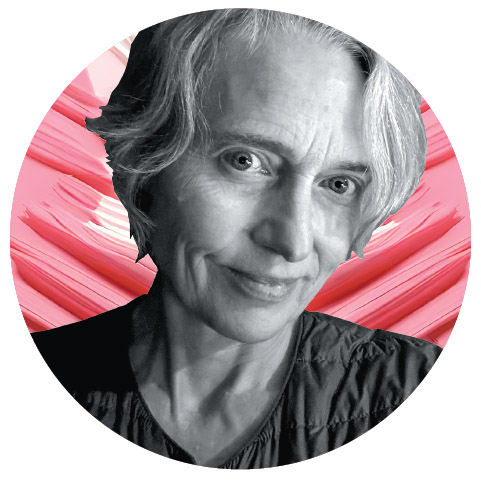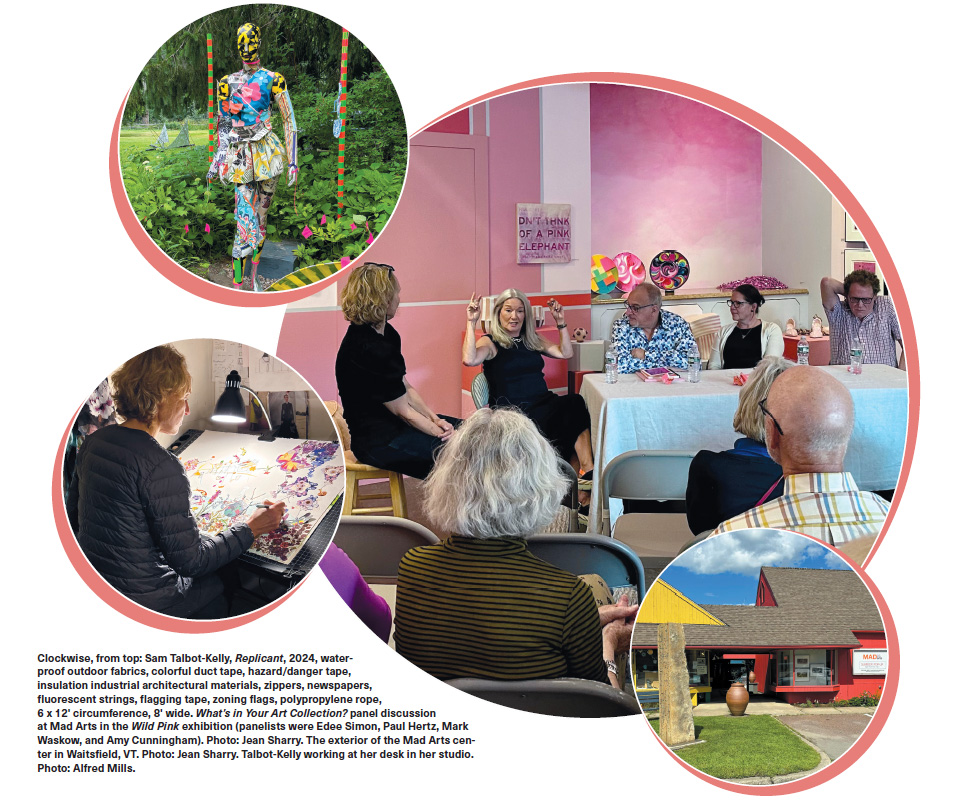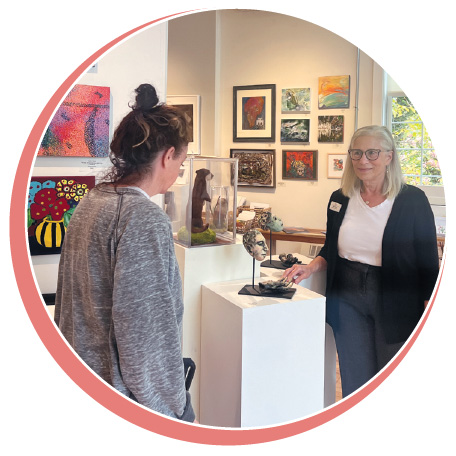GROUNDBREAKING WOMEN
Breaking [a lot of] New Ground
NONPROFIT ART CENTERS ARE FOUNDED OUT OF NEED, USUALLY IN GEOGRAPHICAL AREAS where there is a cultural void. They seem to emerge organically as if a seed was planted that simply grew. Yet as any gardener knows, beautiful flowers and healthy vegetables don’t just magically appear. It takes hard work and tenacity to survive seasons of drought or flood. To be sustainable, every garden, or in this case, every art center, needs a community of supporters and that community must be built and nurtured. The responsibility for organizing and motivating that community often rests on the shoulders of the executive director. These are not glamorous, high-paying jobs and therefore usually fall on the shoulders of women. This is the second installment of Art New England’s series honoring those women who have led their organizations through some of the most trying times in recent history. Join us in supporting their achievements.

SAM TALBOT-KELLY
executive director
Mad River Valley Arts
Waitsfield, Vermont
madrivervalleyarts.org
samtkstudios.com
Sustainability is the thread that connects all programs at the non-profit cultural hub Mad River Valley Arts nestled in the center of Waitsfield, Vermont. Sustainability is also what executive director Sam Talbot-Kelly struggles to achieve in her own life as she juggles multiple roles as artist, educator, wife, mother and leader of one of central Vermont’s most important art venues.
British-born, Talbot-Kelly found that, “as an artist, moving to Vermont was hard. It was difficult to find community.” This need to “build community” is an integral part of creating a sustainable art ecosystem that will support the careers of the many artists who live and work here. Vermont’s majestic green mountains, verdant valleys, and charming towns have lured artists of every ilk for decades. Creativity blooms in the new studios of Burlington’s South End and in the converted old barns of rural Fairfield, yet the persistent complaint expressed by artists young and old who live here is the lack of places to show and sell their work. Part of this is attributed to the fact that Vermont is the second least populated state, after Wyoming. Artists decry the lack of population density to support a robust creative economy.
Talbot-Kelly succinctly described the problem, “We have a surplus of art and artists in Vermont and not enough demand for their work.” In order to address the issue of an imbalance in supply and demand, she organized What’s in Your Collection?, a panel discussion held at Mad Arts this fall to discuss the relationship between art and money as it effects the Vermont cultural ecosystem. She explained, “I’m concerned because we need to encourage a new generation of collectors. That’s my motivation for this kind of programming.” The participants included Mark Waskow, founder of the newly launched Northern New England Museum of Art, Amy Cunningham of the Vermont Arts Council, Paul E. Hertz, collector and board member at The Current in Stowe, and collector Edee Simon. For those who couldn’t attend in person, a video of the event is available online.
Visibility, both as a physical location and for Mad Art’s programs, is also a concern. Talbot-Kelly remarked, “We recently painted the building next door, so now we are more easily seen from the road.” Color also calls attention and proliferates in Wild Pink, the fall exhibition and group show about “the natural and cultural relationship of the color PINK…” The Mad Arts website elaborates, “Whether to shock, protest or code the millennials, pink has survived the test of time. This show examines the fluid origins of PINK in ‘natural’ and/or ‘cultural’ contexts.” Twenty-seven artists were included in this innovative platform for cutting edge artwork not usually associated with Vermont.
Talbot-Kelly defines her role as “a mediator in running this organization. I mediate between the community and the Board, and between artists and their audience. I also teach—which I like to do.” As an artist herself, Talbot-Kelly relates to the struggles of the artists she exhibits. She manages to complete one major project of her own every year. Her work embraces garment design, mechanical design, illustration, and soft sculpture installation. This year those interests came together in Replicant, installed at SculptureFest, Woodstock, VT. She describes the work: “I think a lot about the Ridley Scott sci-fi movie Blade Runner set in 2049. My figure references the idea of a ‘replicant,’ a constructed being, no emotionality, and therefore a kind of slave to culture/corporate/empire. She is a signifier for human and tech advancement. She is in a setting. I have ritualized this setting as an energetic field with flags and adornment. She is made from leftover building and construction materials; she is to alert as ‘hazard’ potential change whether for good or bad…”
While Talbot-Kelly is realistic about the challenges of maintaining and building a robust exhibition and education program at Mad Arts, she is also grateful for the opportunity and freedom she has an artist to visualize her creative ideas and use her curatorial skills. When she meets obstacles to her efforts at fundraising or feels the burden of the forty-five minute commute to her office and gallery space from Montpelier where she lives, her innate energy and positive problem-solving approach wins out. Talbot-Kelly acknowledges that, “I have huge opportunities in running my own programs. I don’t have enough staff, but I am grateful that my exhibitions are an extension of my own interests. Unconsciously, it’s like testing the market for my own work.” That market needs nurturing in order to grow and Talbot-Kelly intends for Mad Arts to meet the challenge.


SHARI BORAZ
executive director
Alliance for the Visual Arts
AVA Gallery and Art Center
avagallery.org
In 2023, AVA Gallery and Art Center (AVA) celebrated its 50th Anniversary, a rare achievement for any non-profit arts organization and particularly one in rural New England. Founded in 1973 as a community artists gallery in Norwich, Vermont, by Dr. and Mrs. Robert Nye, who registered for non-profit status in 1976, the gallery moved to its current location in Lebanon, NH, in 1990. By 2003, the organization had accumulated the resources to buy its own building, providing stability, sustainability, and a feeling of permanence. In 2016, AVA’s long-standing leader Bente Torjusen West retired after thirty years as executive director. Like many well-established non-profits, when the founder or director departs, a period of adjustment ensues and sometimes that adjustment can be rocky. It is even referred to as “founders’ syndrome” and some organizations do not survive the transition to new leadership. Luckily for AVA, Shari Boraz emerged from a period of shaky attempts to find a new executive director and in 2021 she took up the challenge and accepted the offer to lead AVA to the next level as a cultural mainstay for all southern Vermont and New Hampshire.
“I want people to feel AVA is their place, their home. It’s a great honor to support artists and I want to bring my passion for art to everyone. I want to create new audiences for ‘real’ art, not prints or posters. There’s nothing like surrounding yourself with real art at home.” — SHARI BORAZ
Growing up in the suburbs of Chicago, Boraz often visited the Art Institute of Chicago with her mother, who was not an artist, yet who encouraged Boraz’s curiosity to explore the arts. It was during her youth that she discovered embroidery, not only as a craft long practiced by women throughout the ages, but as a medium of creative expression. Later Boraz attended the Art Institute of Chicago, where she furthered her knowledge of textiles, studied the history of embroidery, and learned the art of textile design. Early on she fought the relegation of embroidery to “women’s work” and vowed to “take the mystique out of art.”
Boraz is by nature a practical person. Her initiation into the art world was as a teenager when she transitioned her embroidered Levi blue jeans into an award-winning art project. Her much-loved jeans were wearing out, so she adorned them with embroidery as a repair job. “I almost thought of them as sculpture, but it was just an attempt to prolong the life of my jeans. The Levi company sponsored this art project. My work was recognized as art, but it was born out of practicality. ‘Necessity is the mother of invention.’”

Like many women of her generation Boraz married early, at age eighteen. In 1988, she and her husband and two small children moved to Israel. They were idealists although survival there proved difficult. They returned to the United States and in 1998 they moved to New Hampshire. “I had never lived in such a rural place, but I was always sewing.” Boraz managed to parlay her hand-work into a productive resource for her and her family. “I design fabrics. I liked the quietness of being able to work from home. I also acquired a catalogue-based business. I sold Jewish ceremonial and ritual objects among other things. We worked with over three hundred artists and craftspeople. My tasks required inventory management, acquisitions, and bill paying.”
Meanwhile, AVA was growing. In 2008 the renovation of its 140-year-old Carter-Kelsey building received a LEED (Leadership in Energy and Environmental Design) gold rating, and, in 2017, AVA opened its newly constructed Bente Torjusen West Sculptural Studies Building at 9 Bank Street that also received LEED status at the silver level. In 2021, following COVID, AVA was emerging from a stressful situation. Although they were in the envious position of owning the buildings they occupied—“Bente was an amazing fundraiser… Both our buildings are mortgage free”—the buildings were suffering from deferred maintenance as the staff was suffering from the instability of ever-changing leadership. Modest by nature yet self-assured in her vision, Boraz recognized the importance of the “space” AVA occupies, both geographically and culturally. “AVA plays an important role in this community. The only other accessible gallery is The Hood [Museum at Dartmouth]. We are all very isolated. We don’t have a system for networking. I don’t have any compatriots I can call on.”
Then there is the fact of limited resources and finite audiences given the sparse population of rural New England. All arts organizations are fighting for the attention of the same, generally aging, population. Boraz is well-aware of these factors and wants to change the status quo. “I want to be collaborative. I want to grow new leadership and a broader donor base.” Her vehicle to achieving these goals is to breed a sense of inclusivity and court wider audiences. “I want people to feel AVA is their place, their home. It’s a great honor to support artists and I want to bring my passion for art to everyone. I want to create new audiences for ‘real’ art, not prints or posters. There’s nothing like surrounding yourself with real art at home.” Boraz sees the path for the future through collaboration. “Women are natural collaborators. Art provides a big tent. We can all be successful.” Perhaps with the support of Art New England and fellow nonprofit centers, a more collaborative environment lies ahead. Plans are being made for a March 2025 panel, hosted by AVA and Art New England, to continue this discussion. Panelists will include the ground-breaking women being highlighted and adjacent programming will garner the perspectives of younger audiences, educators and artists across the region.
